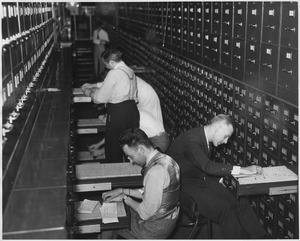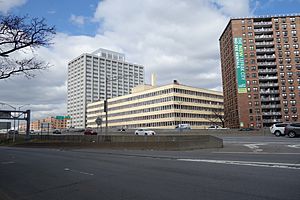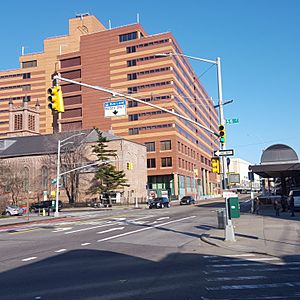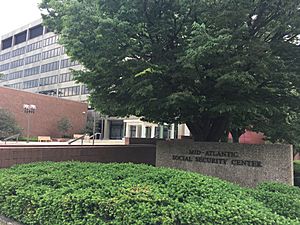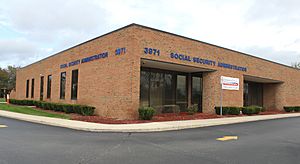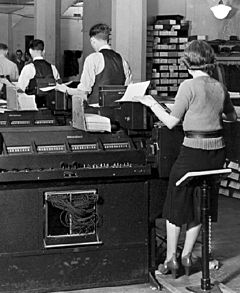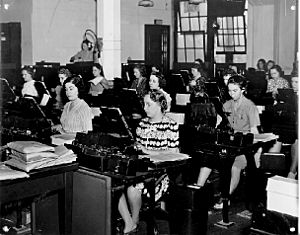Social Security Administration facts for kids

Official seal of the Social Security Administration
|
|

Flag of the Social Security Administration
|
|
| Agency overview | |
|---|---|
| Formed | August 14, 1935 |
| Jurisdiction | Federal government of the United States |
| Headquarters | Woodlawn, Maryland, U.S. |
| Employees | 60,000 |
| Annual budget | $1.06 trillion (FY 2018) |
| Agency executive |
|
The United States Social Security Administration (SSA) is a special agency of the U.S. government. Its main job is to manage a program called Social Security. This program helps people by providing money when they retire, become disabled, or if a family member who worked passes away.
To get most of these benefits, workers pay Social Security taxes from their earnings. The amount of money they receive later depends on how much they contributed. Other benefits, like Supplemental Security Income (SSI), are given to people based on their financial needs.
The Social Security Administration started in 1935 as the "Social Security Board." It got its current name in 1946. Its main office is in Woodlawn, Maryland, near Baltimore. As of 2018, about 60,000 people worked for the SSA. Social Security is the biggest program in the United States that helps people financially.
Contents
How Social Security Started
The Social Security program began as part of President Franklin D. Roosevelt's plan called the New Deal. This happened when the Social Security Act of 1935 was signed on August 14, 1935. At first, the agency was called the Social Security Board (SSB). It started with no money, no staff, and no furniture! It got some temporary funds from another government agency.
The very first Social Security office opened in Austin, Texas, on October 14, 1936. People started paying Social Security taxes in January 1937. The first person to receive regular monthly retirement money was Ida May Fuller from Brattleboro, Vermont. Her first check, sent on January 31, 1940, was for $22.54.
In 1939, the Social Security Board became part of a larger group of agencies called the Federal Security Agency. In January 1940, the first regular monthly benefits started being paid out. The SSB was officially renamed the Social Security Administration in 1946 by President Harry S. Truman.
Later, in 1953, the SSA became part of the Department of Health, Education, and Welfare. This department later became the Department of Health and Human Services in 1980. In 1994, President Bill Clinton made the SSA an independent agency again. This means it works on its own within the government. Also, in 1972, a system called Cost of Living Adjustments (COLAs) was added. This helps Social Security payments keep up with rising prices due to inflation.
Who Has Led Social Security?
Many people have served as the Commissioner, or leader, of Social Security. Here is a list of some of them:
- Arthur J. Altmeyer (1946 – 1953)
- William L. Mitchell (Acting) (1953)
- John W. Tramburg (1953 – 1954)
- Charles I. Schottland (1954 – 1958)
- William L. Mitchell (1959 – 1962)
- Robert M. Ball (1962 – 1973)
- Arthur E. Hess (Acting) (1973)
- James B. Cardwell (1973 – 1977)
- Don I. Wortman (Acting) (1977 – 1978)
- Stanford G. Ross (1978 – 1979)
- William J. Driver (1980 – 1981)
- John A. Svahn (1981 – 1983)
- Martha A. McSteen (Acting) (1983 – 1986)
- Dorcas R. Hardy (1986 – 1989)
- Gwendolyn S. King (1989 – 1992)
- Shirley S. Chater (1993 – 1997)
- Kenneth S. Apfel (1997 – 2001)
- Jo Anne B. Barnhart (2001 – 2007)
- Michael J. Astrue (2007 – 2013)
- Carolyn W. Colvin (Acting) (2013 – 2017)
- Nancy A. Berryhill (Acting) (2017 – 2019)
- Andrew M. Saul (2019–Present)
Where Social Security Works
The SSA was one of the first government agencies to have its main office outside of Washington, D.C.. It was first located in Baltimore because they needed a very large building to store all the paper records. No suitable building was available in Washington in 1936.
A new building was planned for Washington, but World War II started, and the military took it over. After the war, it was decided it would be too hard to move the agency. So, the SSA stayed in Baltimore until 1960. Then, it moved to its new, specially built headquarters in Woodlawn, Maryland.
The road leading to the headquarters is called Security Boulevard. It's a major road connecting Baltimore to its western suburbs. Even a nearby shopping center is named Security Square Mall.
Many SSA employees also work in other offices because the main headquarters is very large and sometimes needs renovations. For example, the office that handles disability appeals is in Falls Church, Virginia.
How Benefits Are Processed
A lot of the work to start new benefits or change existing ones happens in six large Program Service Centers across the country. These centers have important jobs like:
- Claims Authorizers: These people, sometimes called claims specialists, set up the first benefits for people.
- Benefits Authorizers: These people handle complicated changes to benefits for those already receiving them. This includes things like life events, overpayments, or underpayments.
These six service centers are located in:
- Northeastern Program Service Center, Jamaica, Queens, New York
- Mid-Atlantic Program Service Center, Philadelphia, Pennsylvania
- Southeastern Program Service Center, Birmingham, Alabama
- Great Lakes Program Service Center, Chicago, Illinois
- Mid-America Program Service Center, Kansas City, Missouri
- Western Program Service Center, Richmond, California
These centers have been in these cities since at least the early 1950s. They were first called Area Offices in 1942.
There are also special processing centers in Baltimore for earnings and international operations, and for disability operations.
Before the mid-1970s, these centers were called Payment Centers. They were reorganized to improve how they worked. A new "modules system" was created. In this system, each team (or module) would handle all parts of a claim for a specific group of Social Security numbers. This made the process much better and more efficient.
These centers employ thousands of people, which helps the local economies. Sometimes, moving a center even within the same city can cause political discussions. For example, when the San Francisco center moved to Richmond, California, in the 1970s, some politicians were against it.
Similarly, in the late 1970s, there was a plan to move the New York center from Rego Park to Jamaica, Queens. This move was supported by Congressman Joseph P. Addabbo, who wanted the jobs in his district. But it was opposed by Congressman Benjamin Stanley Rosenthal, whose district would lose the jobs. Despite the debate, the move happened, and the new building in Jamaica opened in 1988. It was named the Joseph P. Addabbo Federal Building.
Who Social Security Helps
When Social Security first started, it covered most workers in the United States. This included people in different states and territories like Alaska and Hawaii. Most workers in businesses that crossed state lines were included, except for railroad workers and most state and local government workers. In 1939, the age limit for joining Social Security was removed.
Railroad workers have their own retirement system called the Railroad Retirement Board. They still have it today, though part of their pension is like Social Security. Railroad workers also participate in Medicare.
Most state and local government workers eventually joined Social Security through special agreements. All state and local government employees hired since 1986 must participate in Medicare, even if they don't get Social Security financial benefits. Some state and local governments have their own pension plans and don't participate in Social Security.
Retirement, Survivors, and Disability Benefits
The SSA manages programs that provide monthly money to:
- Older workers who have retired.
- Their spouses and children.
- Families of workers who have passed away.
- Workers who become disabled.
In 2010, over 54 million Americans received about $712 billion in Social Security benefits. These programs are mostly paid for by taxes that workers, their employers, and self-employed people pay each year. This money goes into a special trust fund. These programs are known together as Retirement, Survivors, Disability Insurance (RSDI).
The SSA also has an office called the Office of Disability Adjudication and Review (ODAR). This office helps decide who gets disability benefits. They have offices all over the U.S. The RSDI program is a very important source of income for many people. The SSA tries to make it easier for people with low incomes or those experiencing homelessness to get these benefits if they qualify.
Supplemental Security Income (SSI)
The SSA also runs the Supplemental Security Income (SSI) program. This program is for older, blind, or disabled people who have very limited income and resources. It's based on need, not on how much you paid in taxes. This program used to have different names but was renamed SSI and given to the SSA in 1973.
SSI payments come from the general money of the United States government. Some states also add more money to SSI payments. As of January 2018, over 8 million people receive SSI.
To get SSI, you must meet certain rules. For example, you usually need to be a U.S. citizen or a documented resident. You also need to have less than $2,000 in money or valuable items. If you give away money or valuable items just to qualify, you might not get SSI for up to 36 months. Even if you don't have a Social Security Number, you can apply. However, if you don't meet the basic rules, your application will likely be denied quickly.
Medicare Help
The main part of the Medicare program is managed by the Centers for Medicare and Medicaid Services. However, SSA offices help people figure out if they can get Medicare. They also help with some payments and provide information. The SSA also helps people with low incomes pay for their Medicare Part D prescription drug plans. This program can help reduce monthly Part D costs by up to $40.
How Social Security Works Day-to-Day
To make sure everyone is treated fairly and efficiently, the SSA has a huge guide called the Program Operations Manual System (POMS). This book explains almost every detail of how the SSA works. It describes many different situations that SSA staff might encounter and the exact rules and steps to follow for each one.
Using Technology
Even before modern computers were invented, Social Security used special machines that worked with punched cards. This technology was very advanced for its time. It helped the Social Security system work very efficiently. The costs of running the SSA have always been a very small part of the total money paid out in benefits.
Deciding on Claims
The SSA has its own system for making decisions about claims. If a claim for benefits is denied, or only partly approved, people can appeal. These appeals are heard by special judges called Administrative Law Judges. They work at offices across the U.S. called the Office of Disability Adjudication and Review (ODAR).
If someone is still unhappy with the decision, they can appeal to the Appeals Council. If they are still not satisfied, they can even appeal to a U.S. District Court. ODAR also handles disagreements about retirement claims. Sometimes, they decide on issues like who a child's parent is or if a marriage is valid when someone applies for benefits based on a spouse's or parent's work history.
Baby Name Report
Every year, just before Mother's Day, the SSA shares a list of the most popular baby names in the United States from the previous year. This list is based on the names given to babies when their parents apply for Social Security cards. The report includes the 1,000 most common names for both boys and girls. You can find the full list and search for names from past years on the SSA website.
See also
 In Spanish: Administración del Seguro Social para niños
In Spanish: Administración del Seguro Social para niños


